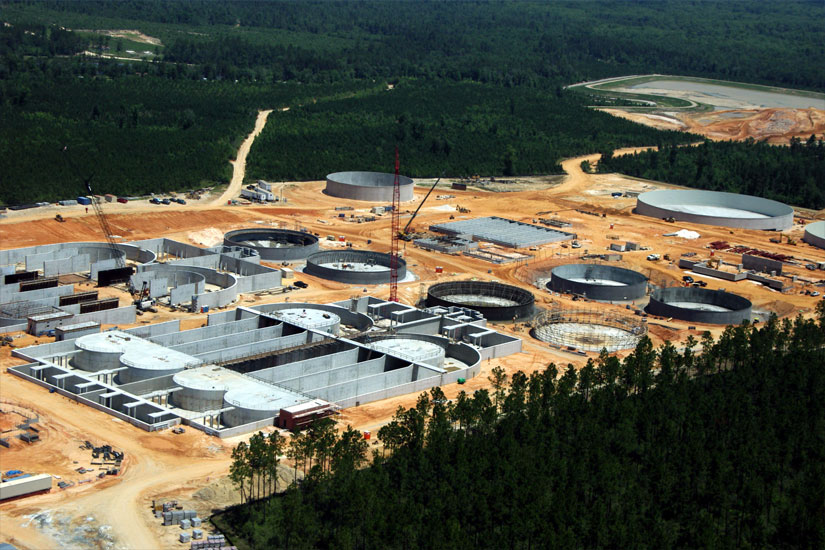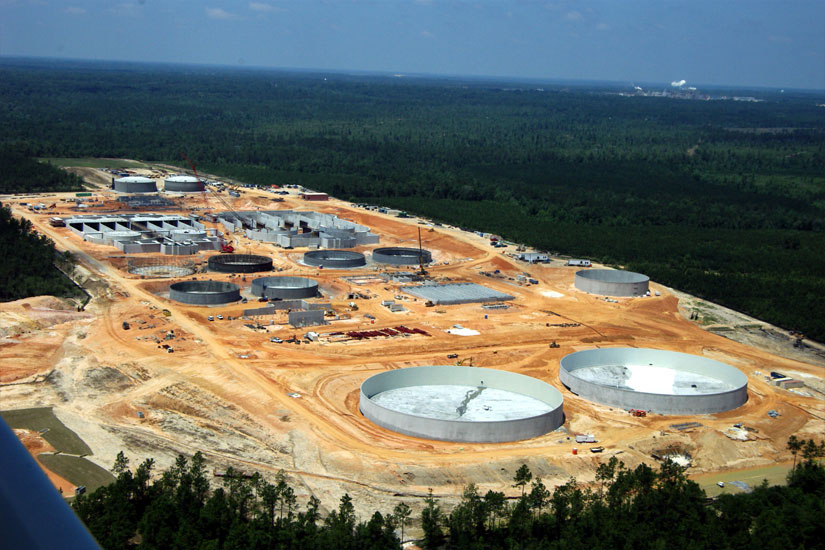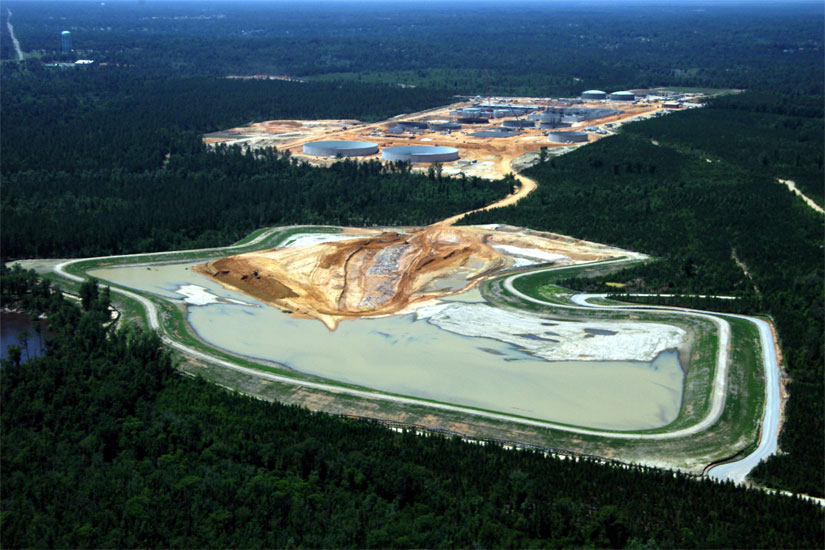New ECUA Plant Pumps $44 Million Into Local Economy
June 15, 2009
The construction of the new Emerald Coast Utilities Authority Century Water Reclamation Facility in Cantonment pumped $44.4 million into the county’s economy, ECUA says.
The new facility replaces the 73-year old downtown Pensacola Main Street Wastewater Treatment Plant and is the largest public works project in Escambia County’s history.
“Any economic development plan that hopes to be successful must focus on an area’s unique strengths. A brand new, environmentally friendly water reclamation facility that opens large tracts of real estate to commercial and industrial development adds more muscle to the powerful body of strengths already present, but too often overlooked, in the Greater Pensacola area,” according to Dale Perkins, ECUA board member.
There are 184 employees on the plant’s payroll, with 65 percent of them being local residents, ECUA Spokesman Jim Roberts said.
When the CWRF is finished in 2010, ECUA estimates it will have had a $320 million total economic impact, according Roberts. There are 103 suppliers and contractors — 60 of them local — working on the project.
“The Main Street replacement project is having a county-wide economic impact. At a recent dinner of the Century Chamber of Commerce, my friend, former Century Mayor Benny Barnes, asked me ‘is your project helping anyone up here?’,” Larry Walker, ECUA District 5 board member, said. “As I stammered for an answer, a young man across the table introduced himself as a Byrneville resident and a structural engineer working on the project through an engineering subcontract from Baskerville-Donovan, Inc. He then pointed to another man down the table saying, he was a Century resident and was also employed on the Main Street replacement project.”
Pictured above and below: Recent aerial photos of the new ECUA Central Water Reclamation Facility under construct near Cantonment. Submitted photo for NorthEscambia.com, click to enlarge.
Comments
8 Responses to “New ECUA Plant Pumps $44 Million Into Local Economy”






Is there a map available that will show existing lift stations and the proposed site of new neighborhood lift stations? If one of these is coming to my yard I WANT TO KNOW!
Ken wrote, as follows: “This is all fine and dandy BUT have any of these people thought about power outages during hurricanes no power to pumping station kinda defeats the purpose of moving the sewage plant,during a major storm,(Ivan) Instead of having POO POO on the street Down Town your going to have POO POO in peoples homes, the Ins. company’s are really going to love this one.”
Response to Ken:
Yes, Ken, “these people” at ECUA HAVE thought about power outages. The results of this thinking are, as follows:
(1) Each of the major lift stations (or “pumping stations”) along the major transmission line from south to north will have a back-up generator to provide power, in the event that Gulf Power service should be knocked out. Many existing lift stations have back-up generators, so this is old hat to “these people” at ECUA. (2) The new treatment plant itself will have THREE sources of electric power: (a) a feed from Gulf Power’s Crist Plant, (b) a feed from Alabama Power, and (c) back-up on-site generators capable of powering the entire plant.
Sorry, Ken, but ECUA people are not the nincompoops that you wish to brand us as.
Serious comments, suggestions, and questions are always welcomed at larry@larrywalker.com.
Why not build the new powerplant instead of destroying the whole county…………
This is all fine and dandy BUT have any of these people thought about power outages during hurricanes no power to pumping station kinda defeats the purpose of moving the sewage plant,during a major storm,(Ivan) Instead of having POO POO on the street Down Town your going to have POO POO in peoples homes, the Ins. company’s are really going to love this one
Response to Yellar Hammer:
ECUA’s Central Water Reclamation Facility (CWRF) is a $300 million plus project. It simply has not been feasible to direct all of that money to local companies. There are three principal reasons for this.
First, roughly one-half of the toal expenditure is for materiel such as pipe and pipe valves, lift-station components, and CWRF plant components. All of the major materiel items are produced outside of our area; therefore, that part of the CWRF money MUST go outside our area.
Second, some of the sixteen major contracts in the CWRF project are of such magnitude that local contractors may be unable to post the required performance bonds and to purchase the insurance required. Because of this factor, all bidders on the CWRF plant construction were larger out-of-town firms. The winning bid was that of Brasfield & Gorie, Inc., of Birmingham.
Third, all contracts are awarded on the basis of competitive bidding. As the spender of rate-payers’ dollars, ECUA must award each contract to the company that submits the “lowest and best” bid. ECUA cannot guarantee that every contract will go to a local company.
Nonetheless, ECUA is a major user of local engineering and construction companies, year in and year out. Local firms have won some of the contracts in the CWRF project. Utility Services Company of Gulf Breeze won one of the three major pipeline contracts. A second of these three major pipeline contracts was won by a firm located in Baker, in Okaloosa County. A Pensacola firm, A. E. New, Inc. won the contract for construction of the headquarters building at the CWRF. Local firms are in the running for a new laboratory building and a new administration building at Ellyson Park.
Many local companies are working as SUBcontractors in the CWRF project. The CWRF will use 70 percent of the total production of USA Pensacola Concrete for twelve months or more. Mansfield Industrial Coatings and Robertson-Curtis Painting Contractor have sizable subcontracts. I have visited the CWRF site dozens of times and have never failed to see work trucks of local companies on site. Davis Marine Construction Co. is doing bulkhead work on new lift stations. Engineering design is being done primarily by two local firms, and they are subbing out engineering work to several other local firms. Local companies are making changes to nearly 50 ECUA lift stations in order to redirect sewage flows.
I would not hazard to state a specific dollar amount for the local financial impact of ECUA’s CWRF project, but I am certain that it is THE biggest contributor to our local economy in this difficult time. In addition to the CWRF project, ECUA is engaged in other economy-boosting activities, such as, (a) construction of a new sewage pipeline from Pensacola Naval Air Station to ECUA’s Bayou Marcus Wastewater Treatment Plant, (b) construction of new sewer lines in Navy Point and several other neighborhoods, and (c) construction of a new sewer line along Gulf Beach Highway.
Response to Guest:
ECUA purchased 2,300 acres for the new facility, including all the undeveloped land on the south side of Beck’s Lake Road and even some acreage on the road’s north side. It did so because of an initial expectation that 2000 acres would be needed as spray fields and wetlands for the disposal of treated wastewater (effluent).
It turns out that Gulf Power and International Paper are going to take approximately 100 percent of the effluent from the new plant for industrial reuse; therefore, ECUA bought more land that it now appears will be needed. About 150 acres is now being developed as the site of the new plant, and 250 acres of spray fields will be developed for occasional use, as needed, to dispose of excessive effluent. There is no immediate use for the additional 1,900 acres.
At the same time, ECUA cannot be certain that the industrial-reuse plans of Gulf Power and International Paper will work out; therefore, for the time being, ECUA must retain the initially purchased acreage for possible development as spray fields and wetlands.
ECUA may use the 1,900 acres for purposes other than the original plan of spray fields and wetlands for effluent disposal. Possible use as a wind-turbine farm or a solar-panel farm (for power generation) has been considered. These options are not economically feasible at present, but they might be feasible in the future. Another–and more promising–use may be as a water-well field to provide water for the ECUA water system. If a form of power generation should become feasible in the future, the 1,900 acres could serve dual purposes.
It is possible that, some day, ECUA will sell land along Beck’s Lake Road for residential or industrial development; however, at present, there is no such demand for that land.
For the present, ECUA will retain the 1,900 acres in an undeveloped state, providing habitat for native plants and animals. The undeveloped acreage will also serve as a large buffer around Spring Lake, which will continue to be a recreation area for paper-mill employees and retirees.
It is my hope that ECUA will be able to permit some public use of the land–such as, for a public-access hiking trail.
I welcome suggestions of other possible beneficial uses of the 1,900 acres. If you have an idea, please email me.
I have my doubts about the money that ECUA claims is pumped in to the economy. There are plenty of local contractors that could have installed the project with out having to go to out of town UNION contractors. Maybe if local contractors where used all the money could have stayed in the local economy.
What with all the signs on Becks Lake road saying (Warning Felony offence if caught trespassing) These signs are all along Becks Lake road where we always went 4-wheeling. Do they realy need all this property I could see close to the plant Does anybody know whats up